Assignment || Social Responsibility
VerifiedAdded on 2022/08/13
|12
|3283
|15
AI Summary
Contribute Materials
Your contribution can guide someone’s learning journey. Share your
documents today.
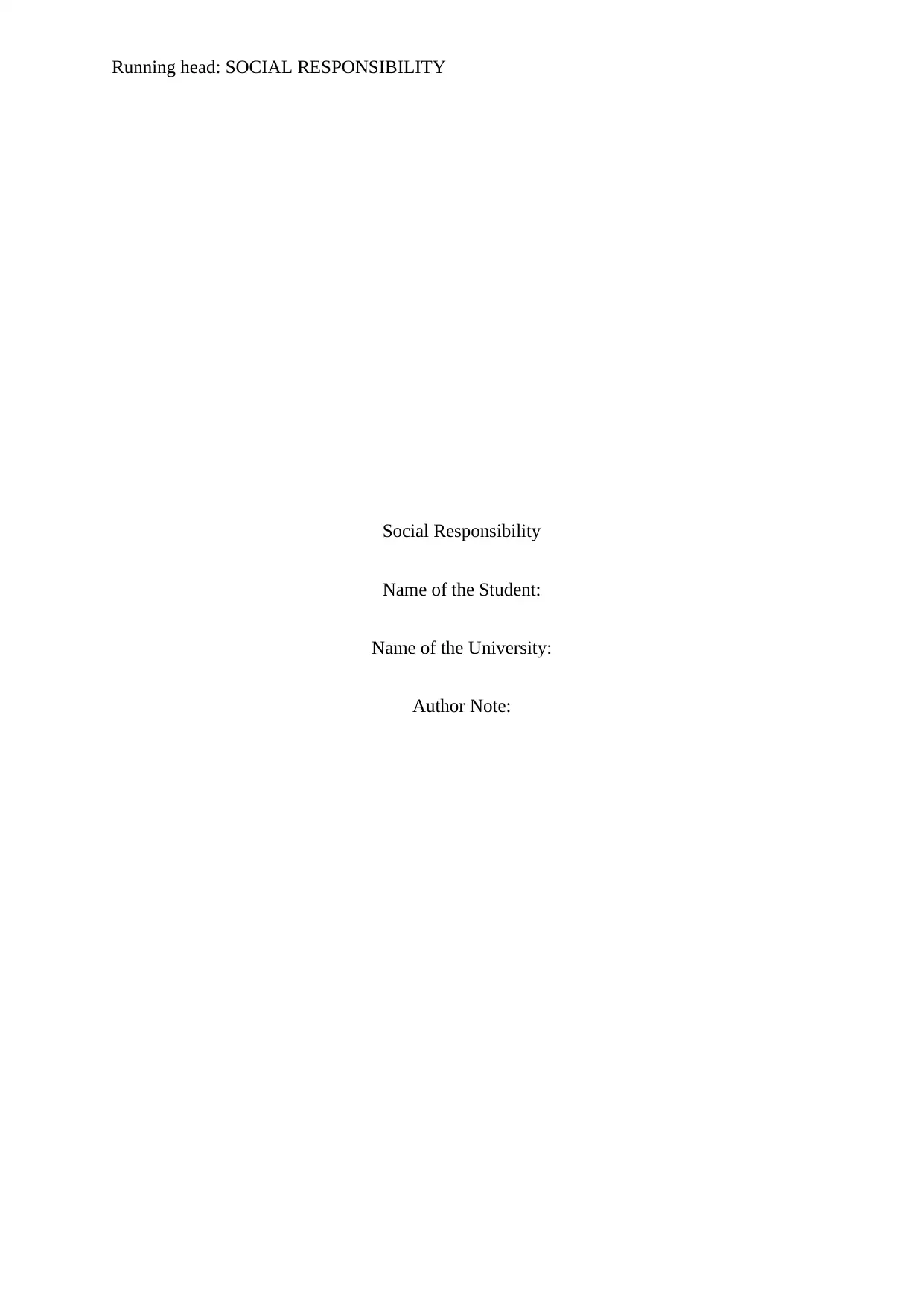
Running head: SOCIAL RESPONSIBILITY
Social Responsibility
Name of the Student:
Name of the University:
Author Note:
Social Responsibility
Name of the Student:
Name of the University:
Author Note:
Secure Best Marks with AI Grader
Need help grading? Try our AI Grader for instant feedback on your assignments.
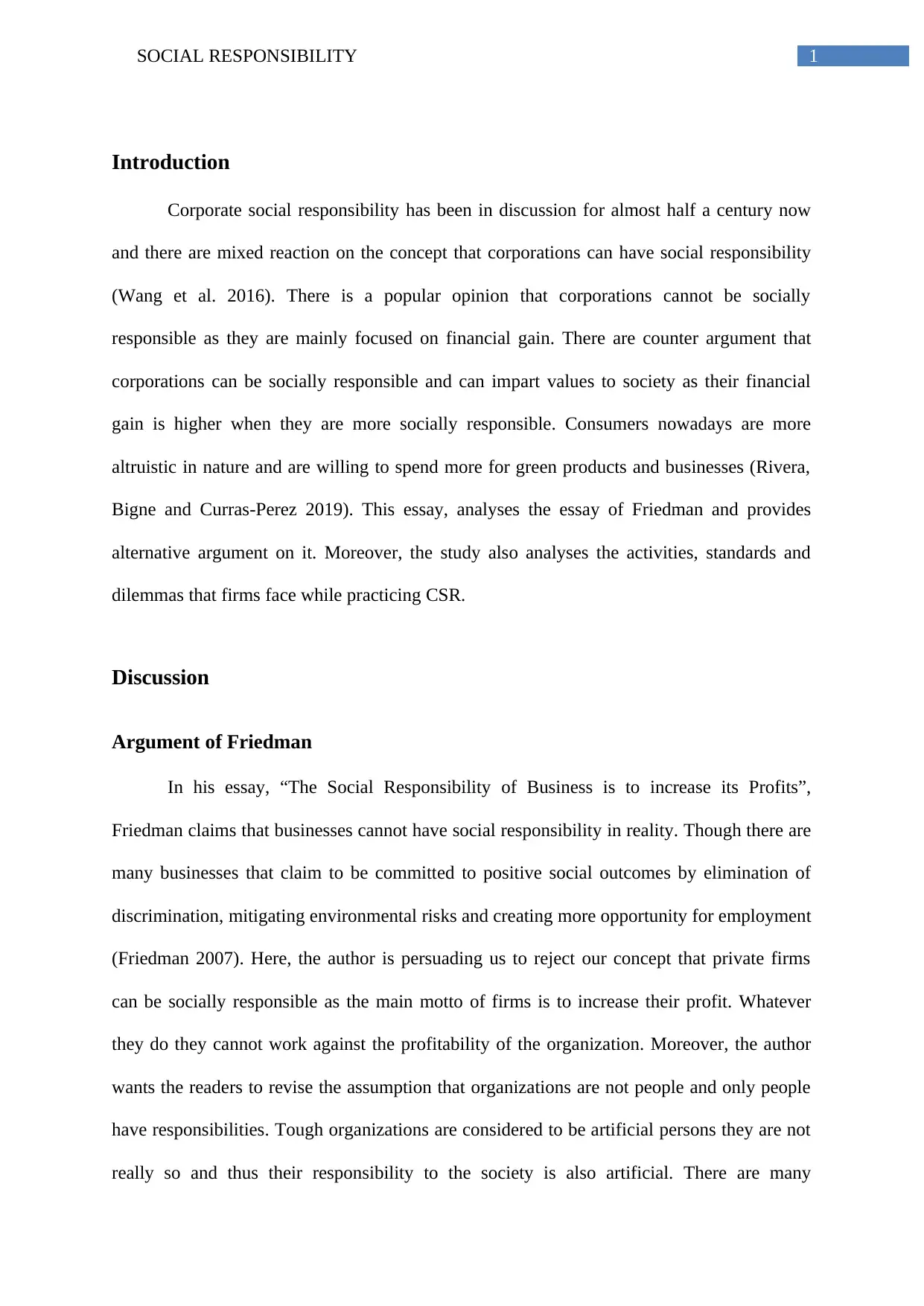
1SOCIAL RESPONSIBILITY
Introduction
Corporate social responsibility has been in discussion for almost half a century now
and there are mixed reaction on the concept that corporations can have social responsibility
(Wang et al. 2016). There is a popular opinion that corporations cannot be socially
responsible as they are mainly focused on financial gain. There are counter argument that
corporations can be socially responsible and can impart values to society as their financial
gain is higher when they are more socially responsible. Consumers nowadays are more
altruistic in nature and are willing to spend more for green products and businesses (Rivera,
Bigne and Curras-Perez 2019). This essay, analyses the essay of Friedman and provides
alternative argument on it. Moreover, the study also analyses the activities, standards and
dilemmas that firms face while practicing CSR.
Discussion
Argument of Friedman
In his essay, “The Social Responsibility of Business is to increase its Profits”,
Friedman claims that businesses cannot have social responsibility in reality. Though there are
many businesses that claim to be committed to positive social outcomes by elimination of
discrimination, mitigating environmental risks and creating more opportunity for employment
(Friedman 2007). Here, the author is persuading us to reject our concept that private firms
can be socially responsible as the main motto of firms is to increase their profit. Whatever
they do they cannot work against the profitability of the organization. Moreover, the author
wants the readers to revise the assumption that organizations are not people and only people
have responsibilities. Tough organizations are considered to be artificial persons they are not
really so and thus their responsibility to the society is also artificial. There are many
Introduction
Corporate social responsibility has been in discussion for almost half a century now
and there are mixed reaction on the concept that corporations can have social responsibility
(Wang et al. 2016). There is a popular opinion that corporations cannot be socially
responsible as they are mainly focused on financial gain. There are counter argument that
corporations can be socially responsible and can impart values to society as their financial
gain is higher when they are more socially responsible. Consumers nowadays are more
altruistic in nature and are willing to spend more for green products and businesses (Rivera,
Bigne and Curras-Perez 2019). This essay, analyses the essay of Friedman and provides
alternative argument on it. Moreover, the study also analyses the activities, standards and
dilemmas that firms face while practicing CSR.
Discussion
Argument of Friedman
In his essay, “The Social Responsibility of Business is to increase its Profits”,
Friedman claims that businesses cannot have social responsibility in reality. Though there are
many businesses that claim to be committed to positive social outcomes by elimination of
discrimination, mitigating environmental risks and creating more opportunity for employment
(Friedman 2007). Here, the author is persuading us to reject our concept that private firms
can be socially responsible as the main motto of firms is to increase their profit. Whatever
they do they cannot work against the profitability of the organization. Moreover, the author
wants the readers to revise the assumption that organizations are not people and only people
have responsibilities. Tough organizations are considered to be artificial persons they are not
really so and thus their responsibility to the society is also artificial. There are many
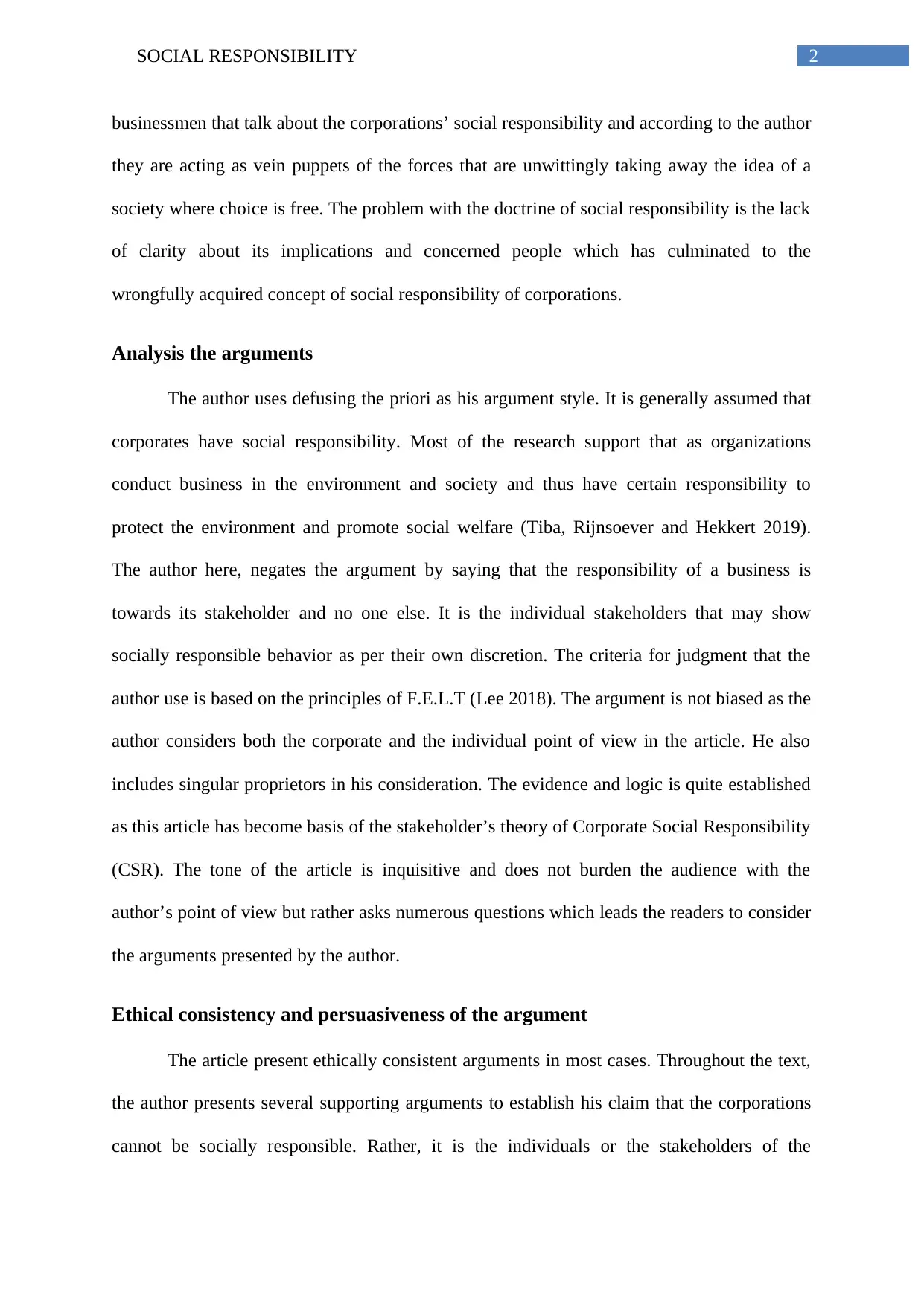
2SOCIAL RESPONSIBILITY
businessmen that talk about the corporations’ social responsibility and according to the author
they are acting as vein puppets of the forces that are unwittingly taking away the idea of a
society where choice is free. The problem with the doctrine of social responsibility is the lack
of clarity about its implications and concerned people which has culminated to the
wrongfully acquired concept of social responsibility of corporations.
Analysis the arguments
The author uses defusing the priori as his argument style. It is generally assumed that
corporates have social responsibility. Most of the research support that as organizations
conduct business in the environment and society and thus have certain responsibility to
protect the environment and promote social welfare (Tiba, Rijnsoever and Hekkert 2019).
The author here, negates the argument by saying that the responsibility of a business is
towards its stakeholder and no one else. It is the individual stakeholders that may show
socially responsible behavior as per their own discretion. The criteria for judgment that the
author use is based on the principles of F.E.L.T (Lee 2018). The argument is not biased as the
author considers both the corporate and the individual point of view in the article. He also
includes singular proprietors in his consideration. The evidence and logic is quite established
as this article has become basis of the stakeholder’s theory of Corporate Social Responsibility
(CSR). The tone of the article is inquisitive and does not burden the audience with the
author’s point of view but rather asks numerous questions which leads the readers to consider
the arguments presented by the author.
Ethical consistency and persuasiveness of the argument
The article present ethically consistent arguments in most cases. Throughout the text,
the author presents several supporting arguments to establish his claim that the corporations
cannot be socially responsible. Rather, it is the individuals or the stakeholders of the
businessmen that talk about the corporations’ social responsibility and according to the author
they are acting as vein puppets of the forces that are unwittingly taking away the idea of a
society where choice is free. The problem with the doctrine of social responsibility is the lack
of clarity about its implications and concerned people which has culminated to the
wrongfully acquired concept of social responsibility of corporations.
Analysis the arguments
The author uses defusing the priori as his argument style. It is generally assumed that
corporates have social responsibility. Most of the research support that as organizations
conduct business in the environment and society and thus have certain responsibility to
protect the environment and promote social welfare (Tiba, Rijnsoever and Hekkert 2019).
The author here, negates the argument by saying that the responsibility of a business is
towards its stakeholder and no one else. It is the individual stakeholders that may show
socially responsible behavior as per their own discretion. The criteria for judgment that the
author use is based on the principles of F.E.L.T (Lee 2018). The argument is not biased as the
author considers both the corporate and the individual point of view in the article. He also
includes singular proprietors in his consideration. The evidence and logic is quite established
as this article has become basis of the stakeholder’s theory of Corporate Social Responsibility
(CSR). The tone of the article is inquisitive and does not burden the audience with the
author’s point of view but rather asks numerous questions which leads the readers to consider
the arguments presented by the author.
Ethical consistency and persuasiveness of the argument
The article present ethically consistent arguments in most cases. Throughout the text,
the author presents several supporting arguments to establish his claim that the corporations
cannot be socially responsible. Rather, it is the individuals or the stakeholders of the
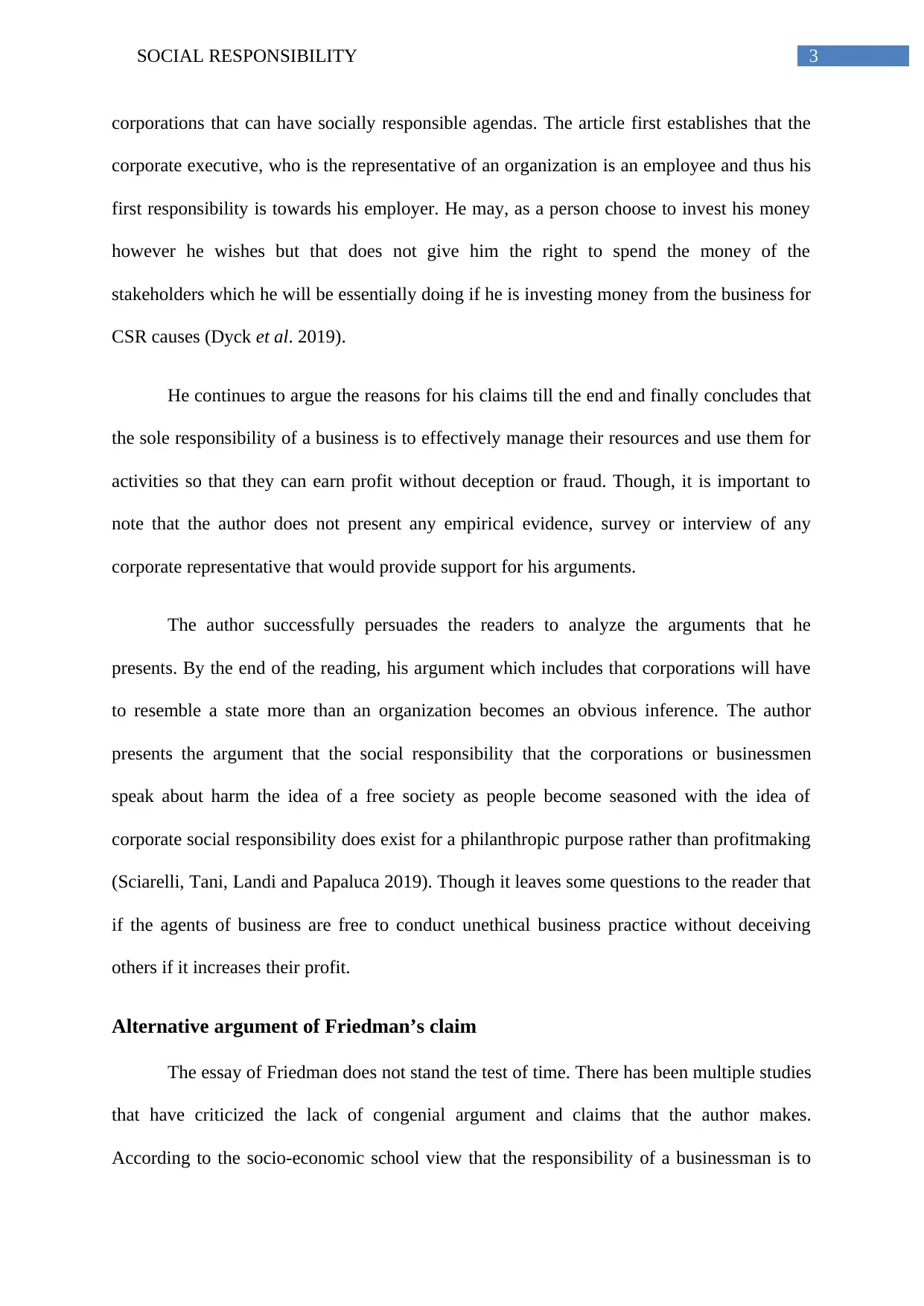
3SOCIAL RESPONSIBILITY
corporations that can have socially responsible agendas. The article first establishes that the
corporate executive, who is the representative of an organization is an employee and thus his
first responsibility is towards his employer. He may, as a person choose to invest his money
however he wishes but that does not give him the right to spend the money of the
stakeholders which he will be essentially doing if he is investing money from the business for
CSR causes (Dyck et al. 2019).
He continues to argue the reasons for his claims till the end and finally concludes that
the sole responsibility of a business is to effectively manage their resources and use them for
activities so that they can earn profit without deception or fraud. Though, it is important to
note that the author does not present any empirical evidence, survey or interview of any
corporate representative that would provide support for his arguments.
The author successfully persuades the readers to analyze the arguments that he
presents. By the end of the reading, his argument which includes that corporations will have
to resemble a state more than an organization becomes an obvious inference. The author
presents the argument that the social responsibility that the corporations or businessmen
speak about harm the idea of a free society as people become seasoned with the idea of
corporate social responsibility does exist for a philanthropic purpose rather than profitmaking
(Sciarelli, Tani, Landi and Papaluca 2019). Though it leaves some questions to the reader that
if the agents of business are free to conduct unethical business practice without deceiving
others if it increases their profit.
Alternative argument of Friedman’s claim
The essay of Friedman does not stand the test of time. There has been multiple studies
that have criticized the lack of congenial argument and claims that the author makes.
According to the socio-economic school view that the responsibility of a businessman is to
corporations that can have socially responsible agendas. The article first establishes that the
corporate executive, who is the representative of an organization is an employee and thus his
first responsibility is towards his employer. He may, as a person choose to invest his money
however he wishes but that does not give him the right to spend the money of the
stakeholders which he will be essentially doing if he is investing money from the business for
CSR causes (Dyck et al. 2019).
He continues to argue the reasons for his claims till the end and finally concludes that
the sole responsibility of a business is to effectively manage their resources and use them for
activities so that they can earn profit without deception or fraud. Though, it is important to
note that the author does not present any empirical evidence, survey or interview of any
corporate representative that would provide support for his arguments.
The author successfully persuades the readers to analyze the arguments that he
presents. By the end of the reading, his argument which includes that corporations will have
to resemble a state more than an organization becomes an obvious inference. The author
presents the argument that the social responsibility that the corporations or businessmen
speak about harm the idea of a free society as people become seasoned with the idea of
corporate social responsibility does exist for a philanthropic purpose rather than profitmaking
(Sciarelli, Tani, Landi and Papaluca 2019). Though it leaves some questions to the reader that
if the agents of business are free to conduct unethical business practice without deceiving
others if it increases their profit.
Alternative argument of Friedman’s claim
The essay of Friedman does not stand the test of time. There has been multiple studies
that have criticized the lack of congenial argument and claims that the author makes.
According to the socio-economic school view that the responsibility of a businessman is to
Secure Best Marks with AI Grader
Need help grading? Try our AI Grader for instant feedback on your assignments.
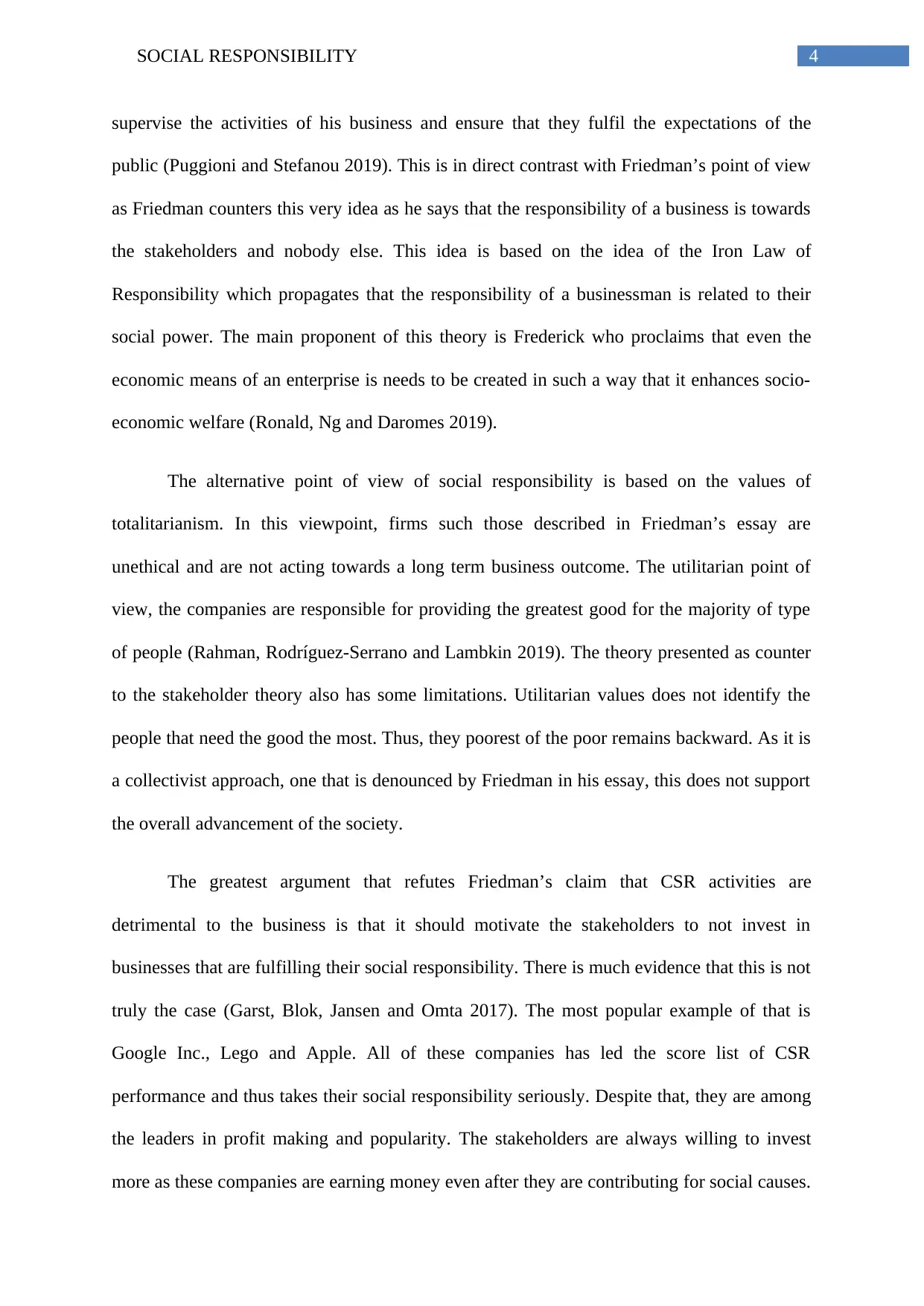
4SOCIAL RESPONSIBILITY
supervise the activities of his business and ensure that they fulfil the expectations of the
public (Puggioni and Stefanou 2019). This is in direct contrast with Friedman’s point of view
as Friedman counters this very idea as he says that the responsibility of a business is towards
the stakeholders and nobody else. This idea is based on the idea of the Iron Law of
Responsibility which propagates that the responsibility of a businessman is related to their
social power. The main proponent of this theory is Frederick who proclaims that even the
economic means of an enterprise is needs to be created in such a way that it enhances socio-
economic welfare (Ronald, Ng and Daromes 2019).
The alternative point of view of social responsibility is based on the values of
totalitarianism. In this viewpoint, firms such those described in Friedman’s essay are
unethical and are not acting towards a long term business outcome. The utilitarian point of
view, the companies are responsible for providing the greatest good for the majority of type
of people (Rahman, Rodríguez-Serrano and Lambkin 2019). The theory presented as counter
to the stakeholder theory also has some limitations. Utilitarian values does not identify the
people that need the good the most. Thus, they poorest of the poor remains backward. As it is
a collectivist approach, one that is denounced by Friedman in his essay, this does not support
the overall advancement of the society.
The greatest argument that refutes Friedman’s claim that CSR activities are
detrimental to the business is that it should motivate the stakeholders to not invest in
businesses that are fulfilling their social responsibility. There is much evidence that this is not
truly the case (Garst, Blok, Jansen and Omta 2017). The most popular example of that is
Google Inc., Lego and Apple. All of these companies has led the score list of CSR
performance and thus takes their social responsibility seriously. Despite that, they are among
the leaders in profit making and popularity. The stakeholders are always willing to invest
more as these companies are earning money even after they are contributing for social causes.
supervise the activities of his business and ensure that they fulfil the expectations of the
public (Puggioni and Stefanou 2019). This is in direct contrast with Friedman’s point of view
as Friedman counters this very idea as he says that the responsibility of a business is towards
the stakeholders and nobody else. This idea is based on the idea of the Iron Law of
Responsibility which propagates that the responsibility of a businessman is related to their
social power. The main proponent of this theory is Frederick who proclaims that even the
economic means of an enterprise is needs to be created in such a way that it enhances socio-
economic welfare (Ronald, Ng and Daromes 2019).
The alternative point of view of social responsibility is based on the values of
totalitarianism. In this viewpoint, firms such those described in Friedman’s essay are
unethical and are not acting towards a long term business outcome. The utilitarian point of
view, the companies are responsible for providing the greatest good for the majority of type
of people (Rahman, Rodríguez-Serrano and Lambkin 2019). The theory presented as counter
to the stakeholder theory also has some limitations. Utilitarian values does not identify the
people that need the good the most. Thus, they poorest of the poor remains backward. As it is
a collectivist approach, one that is denounced by Friedman in his essay, this does not support
the overall advancement of the society.
The greatest argument that refutes Friedman’s claim that CSR activities are
detrimental to the business is that it should motivate the stakeholders to not invest in
businesses that are fulfilling their social responsibility. There is much evidence that this is not
truly the case (Garst, Blok, Jansen and Omta 2017). The most popular example of that is
Google Inc., Lego and Apple. All of these companies has led the score list of CSR
performance and thus takes their social responsibility seriously. Despite that, they are among
the leaders in profit making and popularity. The stakeholders are always willing to invest
more as these companies are earning money even after they are contributing for social causes.
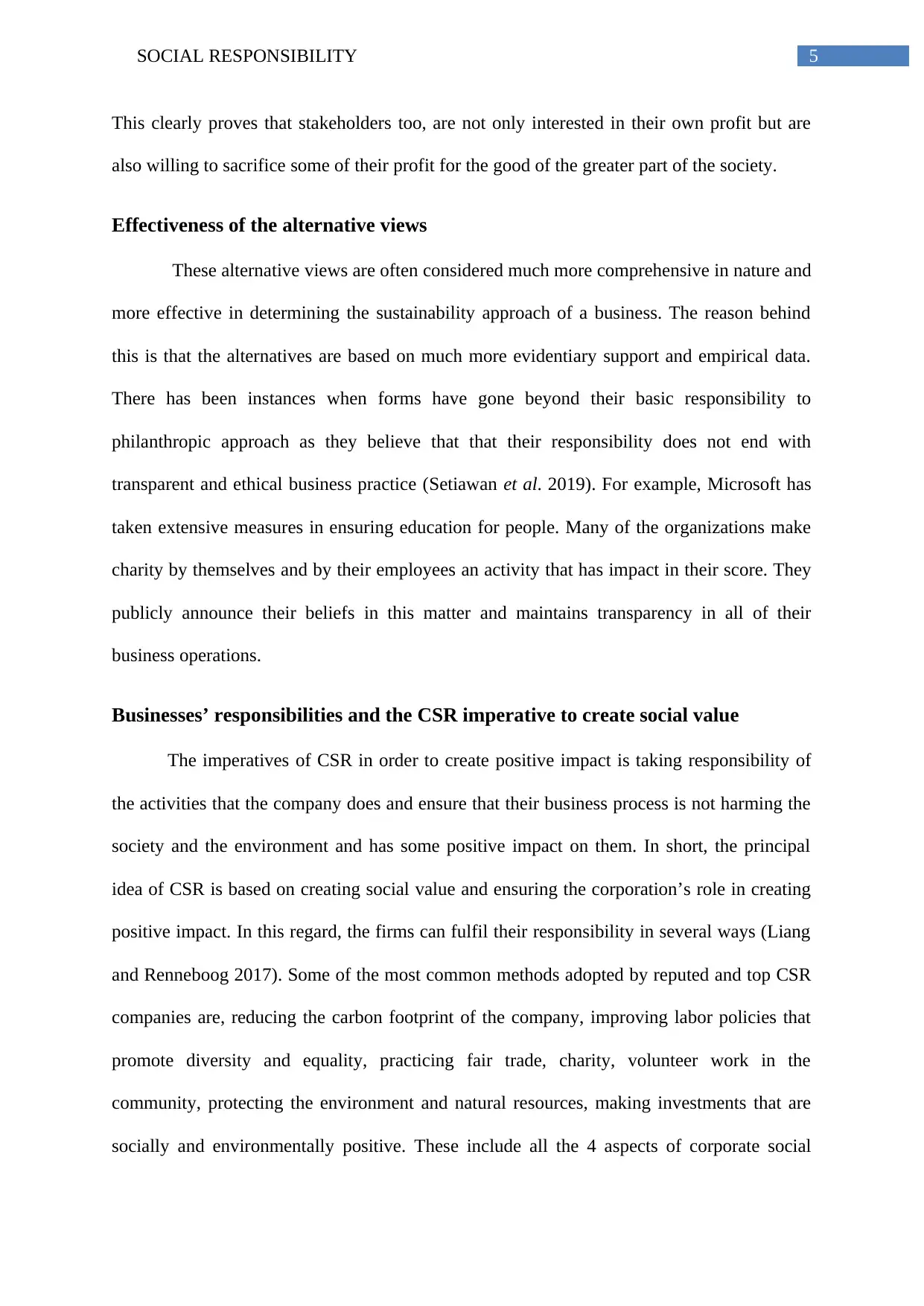
5SOCIAL RESPONSIBILITY
This clearly proves that stakeholders too, are not only interested in their own profit but are
also willing to sacrifice some of their profit for the good of the greater part of the society.
Effectiveness of the alternative views
These alternative views are often considered much more comprehensive in nature and
more effective in determining the sustainability approach of a business. The reason behind
this is that the alternatives are based on much more evidentiary support and empirical data.
There has been instances when forms have gone beyond their basic responsibility to
philanthropic approach as they believe that that their responsibility does not end with
transparent and ethical business practice (Setiawan et al. 2019). For example, Microsoft has
taken extensive measures in ensuring education for people. Many of the organizations make
charity by themselves and by their employees an activity that has impact in their score. They
publicly announce their beliefs in this matter and maintains transparency in all of their
business operations.
Businesses’ responsibilities and the CSR imperative to create social value
The imperatives of CSR in order to create positive impact is taking responsibility of
the activities that the company does and ensure that their business process is not harming the
society and the environment and has some positive impact on them. In short, the principal
idea of CSR is based on creating social value and ensuring the corporation’s role in creating
positive impact. In this regard, the firms can fulfil their responsibility in several ways (Liang
and Renneboog 2017). Some of the most common methods adopted by reputed and top CSR
companies are, reducing the carbon footprint of the company, improving labor policies that
promote diversity and equality, practicing fair trade, charity, volunteer work in the
community, protecting the environment and natural resources, making investments that are
socially and environmentally positive. These include all the 4 aspects of corporate social
This clearly proves that stakeholders too, are not only interested in their own profit but are
also willing to sacrifice some of their profit for the good of the greater part of the society.
Effectiveness of the alternative views
These alternative views are often considered much more comprehensive in nature and
more effective in determining the sustainability approach of a business. The reason behind
this is that the alternatives are based on much more evidentiary support and empirical data.
There has been instances when forms have gone beyond their basic responsibility to
philanthropic approach as they believe that that their responsibility does not end with
transparent and ethical business practice (Setiawan et al. 2019). For example, Microsoft has
taken extensive measures in ensuring education for people. Many of the organizations make
charity by themselves and by their employees an activity that has impact in their score. They
publicly announce their beliefs in this matter and maintains transparency in all of their
business operations.
Businesses’ responsibilities and the CSR imperative to create social value
The imperatives of CSR in order to create positive impact is taking responsibility of
the activities that the company does and ensure that their business process is not harming the
society and the environment and has some positive impact on them. In short, the principal
idea of CSR is based on creating social value and ensuring the corporation’s role in creating
positive impact. In this regard, the firms can fulfil their responsibility in several ways (Liang
and Renneboog 2017). Some of the most common methods adopted by reputed and top CSR
companies are, reducing the carbon footprint of the company, improving labor policies that
promote diversity and equality, practicing fair trade, charity, volunteer work in the
community, protecting the environment and natural resources, making investments that are
socially and environmentally positive. These include all the 4 aspects of corporate social
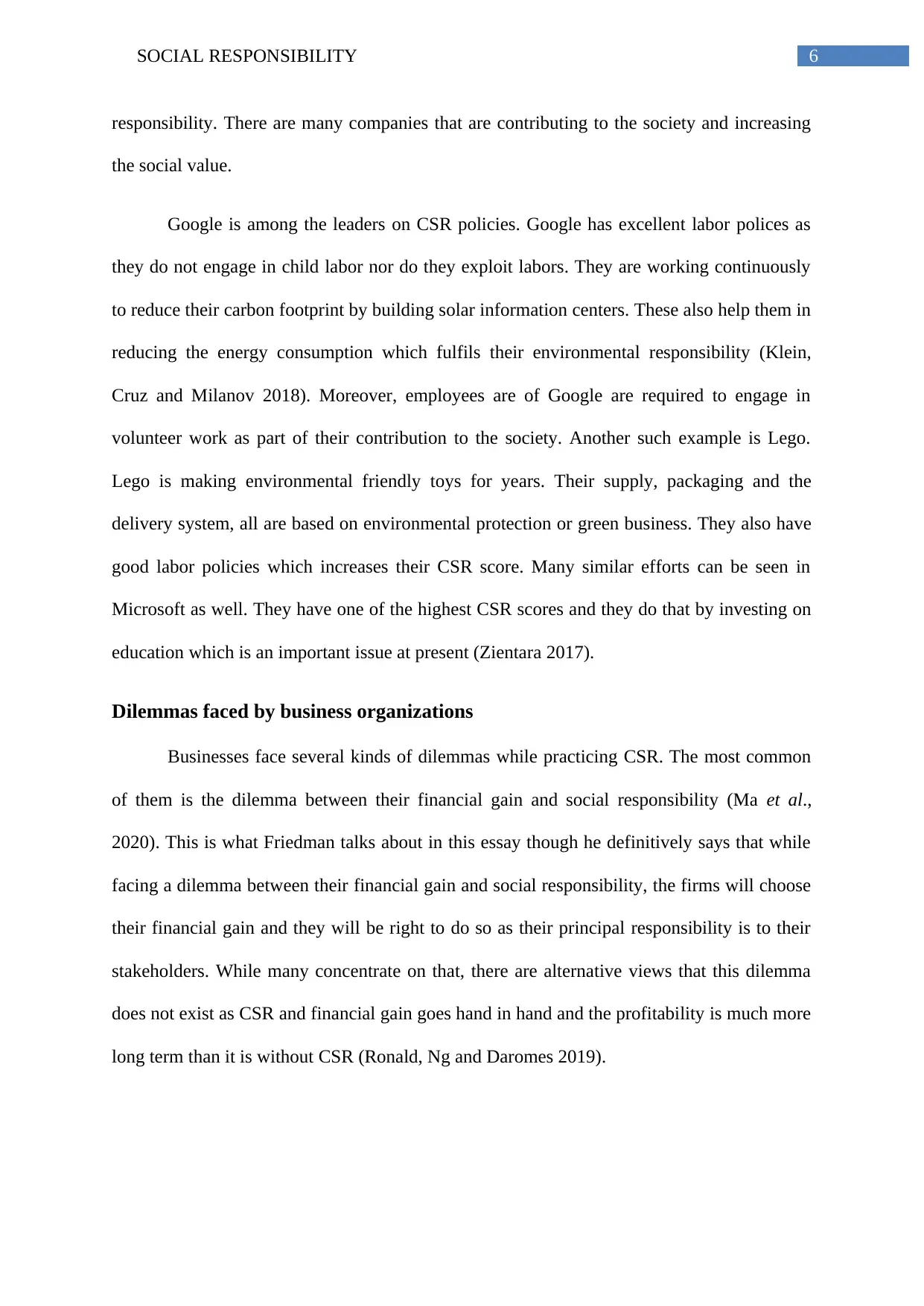
6SOCIAL RESPONSIBILITY
responsibility. There are many companies that are contributing to the society and increasing
the social value.
Google is among the leaders on CSR policies. Google has excellent labor polices as
they do not engage in child labor nor do they exploit labors. They are working continuously
to reduce their carbon footprint by building solar information centers. These also help them in
reducing the energy consumption which fulfils their environmental responsibility (Klein,
Cruz and Milanov 2018). Moreover, employees are of Google are required to engage in
volunteer work as part of their contribution to the society. Another such example is Lego.
Lego is making environmental friendly toys for years. Their supply, packaging and the
delivery system, all are based on environmental protection or green business. They also have
good labor policies which increases their CSR score. Many similar efforts can be seen in
Microsoft as well. They have one of the highest CSR scores and they do that by investing on
education which is an important issue at present (Zientara 2017).
Dilemmas faced by business organizations
Businesses face several kinds of dilemmas while practicing CSR. The most common
of them is the dilemma between their financial gain and social responsibility (Ma et al.,
2020). This is what Friedman talks about in this essay though he definitively says that while
facing a dilemma between their financial gain and social responsibility, the firms will choose
their financial gain and they will be right to do so as their principal responsibility is to their
stakeholders. While many concentrate on that, there are alternative views that this dilemma
does not exist as CSR and financial gain goes hand in hand and the profitability is much more
long term than it is without CSR (Ronald, Ng and Daromes 2019).
responsibility. There are many companies that are contributing to the society and increasing
the social value.
Google is among the leaders on CSR policies. Google has excellent labor polices as
they do not engage in child labor nor do they exploit labors. They are working continuously
to reduce their carbon footprint by building solar information centers. These also help them in
reducing the energy consumption which fulfils their environmental responsibility (Klein,
Cruz and Milanov 2018). Moreover, employees are of Google are required to engage in
volunteer work as part of their contribution to the society. Another such example is Lego.
Lego is making environmental friendly toys for years. Their supply, packaging and the
delivery system, all are based on environmental protection or green business. They also have
good labor policies which increases their CSR score. Many similar efforts can be seen in
Microsoft as well. They have one of the highest CSR scores and they do that by investing on
education which is an important issue at present (Zientara 2017).
Dilemmas faced by business organizations
Businesses face several kinds of dilemmas while practicing CSR. The most common
of them is the dilemma between their financial gain and social responsibility (Ma et al.,
2020). This is what Friedman talks about in this essay though he definitively says that while
facing a dilemma between their financial gain and social responsibility, the firms will choose
their financial gain and they will be right to do so as their principal responsibility is to their
stakeholders. While many concentrate on that, there are alternative views that this dilemma
does not exist as CSR and financial gain goes hand in hand and the profitability is much more
long term than it is without CSR (Ronald, Ng and Daromes 2019).
Paraphrase This Document
Need a fresh take? Get an instant paraphrase of this document with our AI Paraphraser
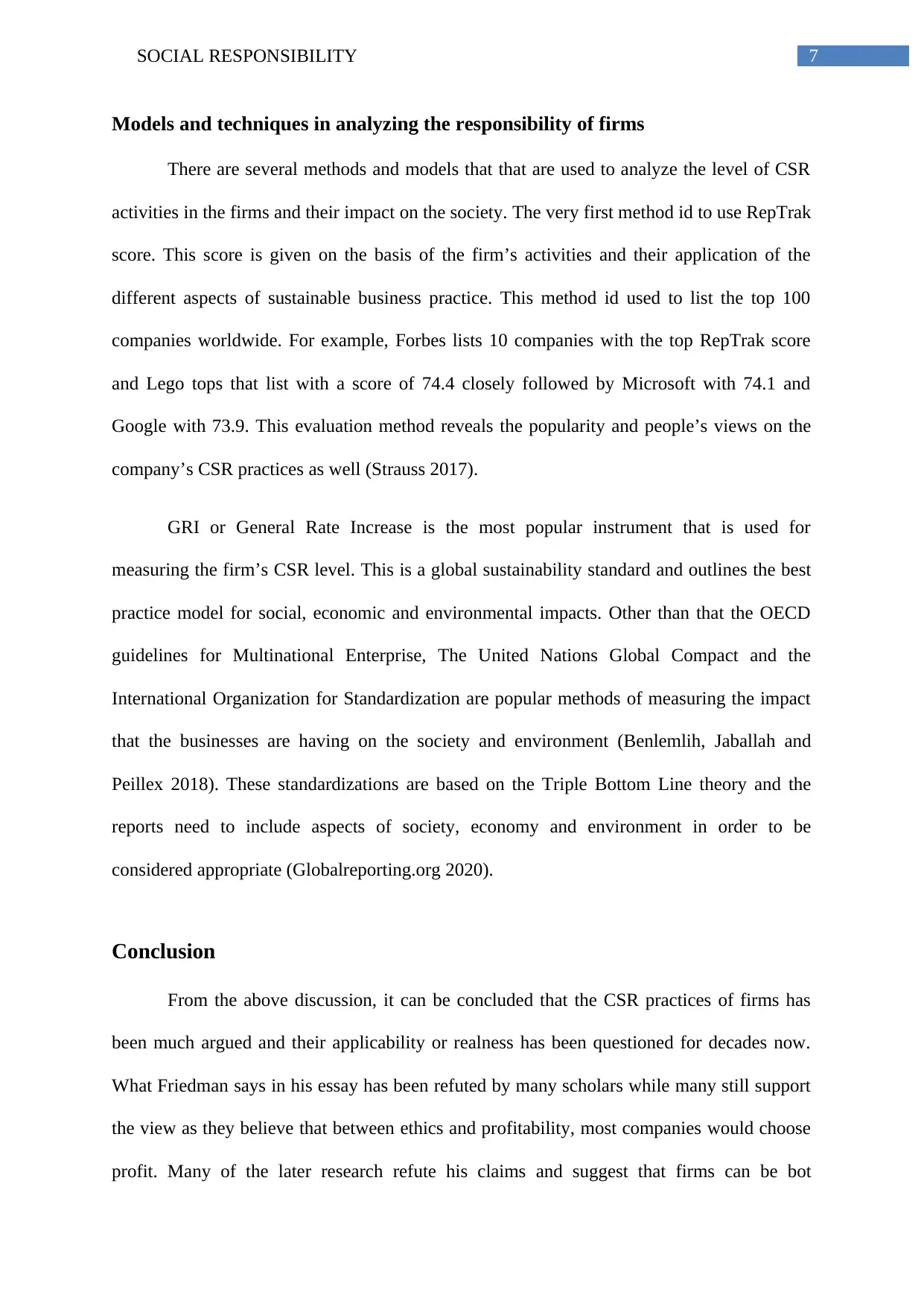
7SOCIAL RESPONSIBILITY
Models and techniques in analyzing the responsibility of firms
There are several methods and models that that are used to analyze the level of CSR
activities in the firms and their impact on the society. The very first method id to use RepTrak
score. This score is given on the basis of the firm’s activities and their application of the
different aspects of sustainable business practice. This method id used to list the top 100
companies worldwide. For example, Forbes lists 10 companies with the top RepTrak score
and Lego tops that list with a score of 74.4 closely followed by Microsoft with 74.1 and
Google with 73.9. This evaluation method reveals the popularity and people’s views on the
company’s CSR practices as well (Strauss 2017).
GRI or General Rate Increase is the most popular instrument that is used for
measuring the firm’s CSR level. This is a global sustainability standard and outlines the best
practice model for social, economic and environmental impacts. Other than that the OECD
guidelines for Multinational Enterprise, The United Nations Global Compact and the
International Organization for Standardization are popular methods of measuring the impact
that the businesses are having on the society and environment (Benlemlih, Jaballah and
Peillex 2018). These standardizations are based on the Triple Bottom Line theory and the
reports need to include aspects of society, economy and environment in order to be
considered appropriate (Globalreporting.org 2020).
Conclusion
From the above discussion, it can be concluded that the CSR practices of firms has
been much argued and their applicability or realness has been questioned for decades now.
What Friedman says in his essay has been refuted by many scholars while many still support
the view as they believe that between ethics and profitability, most companies would choose
profit. Many of the later research refute his claims and suggest that firms can be bot
Models and techniques in analyzing the responsibility of firms
There are several methods and models that that are used to analyze the level of CSR
activities in the firms and their impact on the society. The very first method id to use RepTrak
score. This score is given on the basis of the firm’s activities and their application of the
different aspects of sustainable business practice. This method id used to list the top 100
companies worldwide. For example, Forbes lists 10 companies with the top RepTrak score
and Lego tops that list with a score of 74.4 closely followed by Microsoft with 74.1 and
Google with 73.9. This evaluation method reveals the popularity and people’s views on the
company’s CSR practices as well (Strauss 2017).
GRI or General Rate Increase is the most popular instrument that is used for
measuring the firm’s CSR level. This is a global sustainability standard and outlines the best
practice model for social, economic and environmental impacts. Other than that the OECD
guidelines for Multinational Enterprise, The United Nations Global Compact and the
International Organization for Standardization are popular methods of measuring the impact
that the businesses are having on the society and environment (Benlemlih, Jaballah and
Peillex 2018). These standardizations are based on the Triple Bottom Line theory and the
reports need to include aspects of society, economy and environment in order to be
considered appropriate (Globalreporting.org 2020).
Conclusion
From the above discussion, it can be concluded that the CSR practices of firms has
been much argued and their applicability or realness has been questioned for decades now.
What Friedman says in his essay has been refuted by many scholars while many still support
the view as they believe that between ethics and profitability, most companies would choose
profit. Many of the later research refute his claims and suggest that firms can be bot
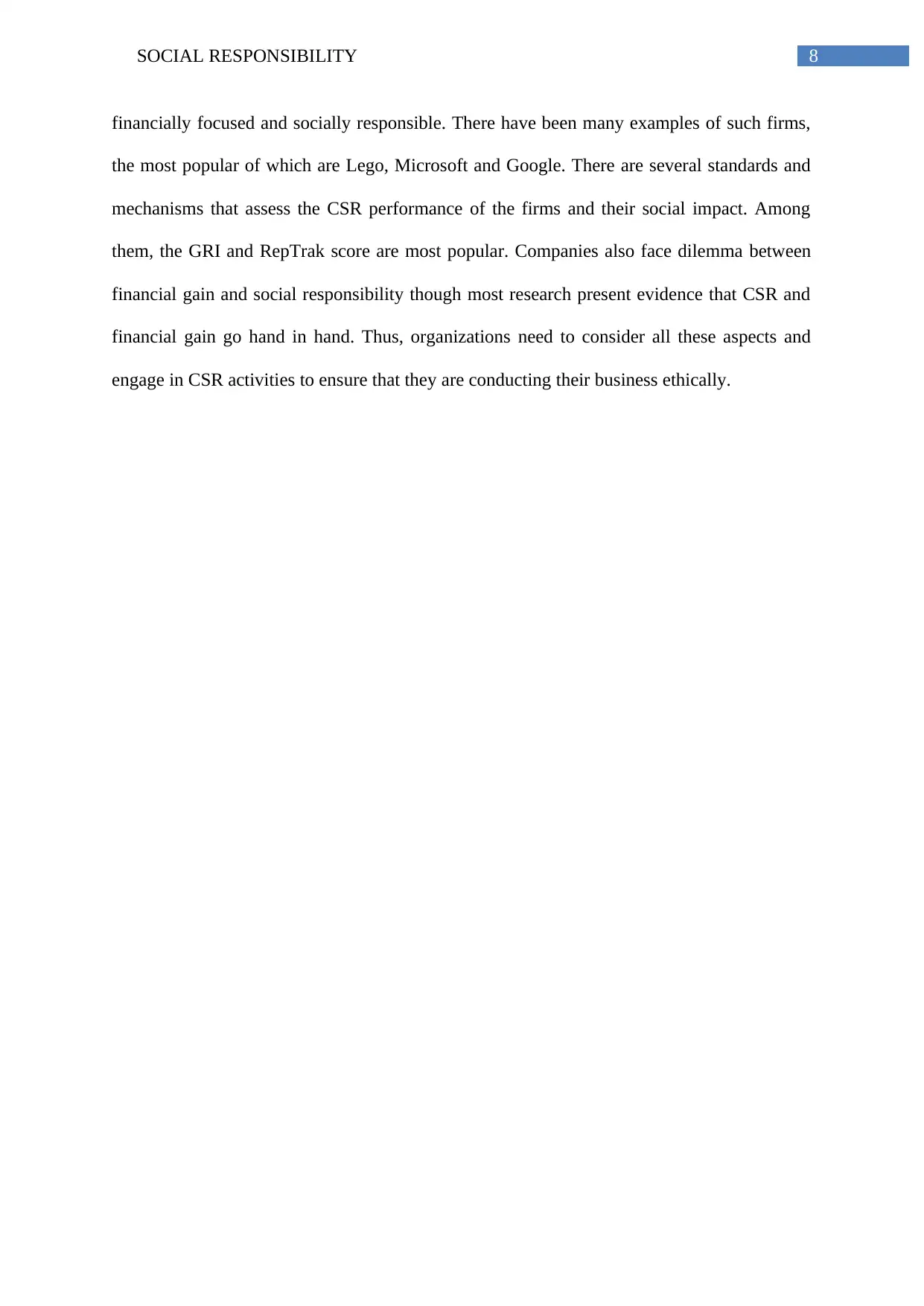
8SOCIAL RESPONSIBILITY
financially focused and socially responsible. There have been many examples of such firms,
the most popular of which are Lego, Microsoft and Google. There are several standards and
mechanisms that assess the CSR performance of the firms and their social impact. Among
them, the GRI and RepTrak score are most popular. Companies also face dilemma between
financial gain and social responsibility though most research present evidence that CSR and
financial gain go hand in hand. Thus, organizations need to consider all these aspects and
engage in CSR activities to ensure that they are conducting their business ethically.
financially focused and socially responsible. There have been many examples of such firms,
the most popular of which are Lego, Microsoft and Google. There are several standards and
mechanisms that assess the CSR performance of the firms and their social impact. Among
them, the GRI and RepTrak score are most popular. Companies also face dilemma between
financial gain and social responsibility though most research present evidence that CSR and
financial gain go hand in hand. Thus, organizations need to consider all these aspects and
engage in CSR activities to ensure that they are conducting their business ethically.
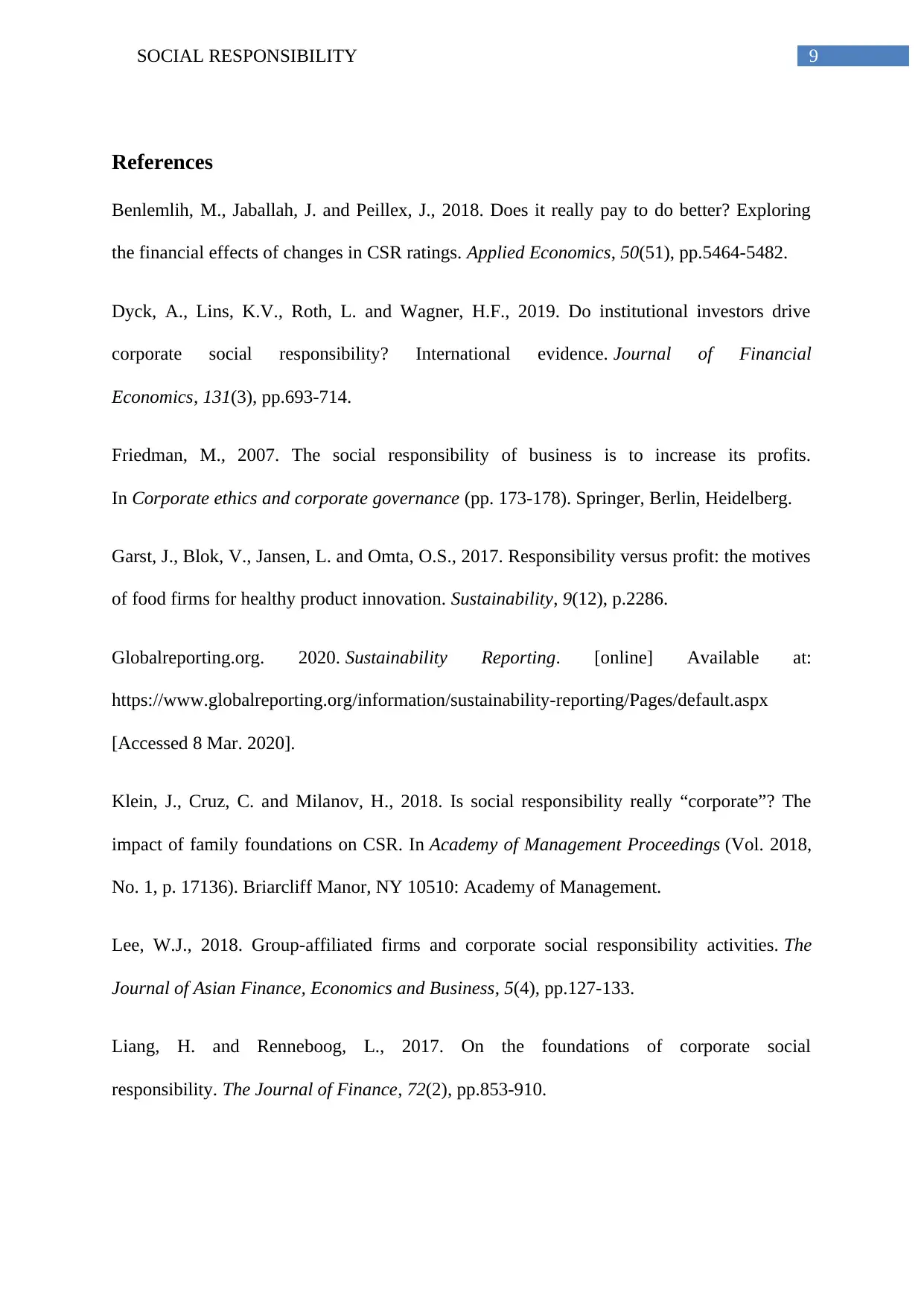
9SOCIAL RESPONSIBILITY
References
Benlemlih, M., Jaballah, J. and Peillex, J., 2018. Does it really pay to do better? Exploring
the financial effects of changes in CSR ratings. Applied Economics, 50(51), pp.5464-5482.
Dyck, A., Lins, K.V., Roth, L. and Wagner, H.F., 2019. Do institutional investors drive
corporate social responsibility? International evidence. Journal of Financial
Economics, 131(3), pp.693-714.
Friedman, M., 2007. The social responsibility of business is to increase its profits.
In Corporate ethics and corporate governance (pp. 173-178). Springer, Berlin, Heidelberg.
Garst, J., Blok, V., Jansen, L. and Omta, O.S., 2017. Responsibility versus profit: the motives
of food firms for healthy product innovation. Sustainability, 9(12), p.2286.
Globalreporting.org. 2020. Sustainability Reporting. [online] Available at:
https://www.globalreporting.org/information/sustainability-reporting/Pages/default.aspx
[Accessed 8 Mar. 2020].
Klein, J., Cruz, C. and Milanov, H., 2018. Is social responsibility really “corporate”? The
impact of family foundations on CSR. In Academy of Management Proceedings (Vol. 2018,
No. 1, p. 17136). Briarcliff Manor, NY 10510: Academy of Management.
Lee, W.J., 2018. Group-affiliated firms and corporate social responsibility activities. The
Journal of Asian Finance, Economics and Business, 5(4), pp.127-133.
Liang, H. and Renneboog, L., 2017. On the foundations of corporate social
responsibility. The Journal of Finance, 72(2), pp.853-910.
References
Benlemlih, M., Jaballah, J. and Peillex, J., 2018. Does it really pay to do better? Exploring
the financial effects of changes in CSR ratings. Applied Economics, 50(51), pp.5464-5482.
Dyck, A., Lins, K.V., Roth, L. and Wagner, H.F., 2019. Do institutional investors drive
corporate social responsibility? International evidence. Journal of Financial
Economics, 131(3), pp.693-714.
Friedman, M., 2007. The social responsibility of business is to increase its profits.
In Corporate ethics and corporate governance (pp. 173-178). Springer, Berlin, Heidelberg.
Garst, J., Blok, V., Jansen, L. and Omta, O.S., 2017. Responsibility versus profit: the motives
of food firms for healthy product innovation. Sustainability, 9(12), p.2286.
Globalreporting.org. 2020. Sustainability Reporting. [online] Available at:
https://www.globalreporting.org/information/sustainability-reporting/Pages/default.aspx
[Accessed 8 Mar. 2020].
Klein, J., Cruz, C. and Milanov, H., 2018. Is social responsibility really “corporate”? The
impact of family foundations on CSR. In Academy of Management Proceedings (Vol. 2018,
No. 1, p. 17136). Briarcliff Manor, NY 10510: Academy of Management.
Lee, W.J., 2018. Group-affiliated firms and corporate social responsibility activities. The
Journal of Asian Finance, Economics and Business, 5(4), pp.127-133.
Liang, H. and Renneboog, L., 2017. On the foundations of corporate social
responsibility. The Journal of Finance, 72(2), pp.853-910.
Secure Best Marks with AI Grader
Need help grading? Try our AI Grader for instant feedback on your assignments.
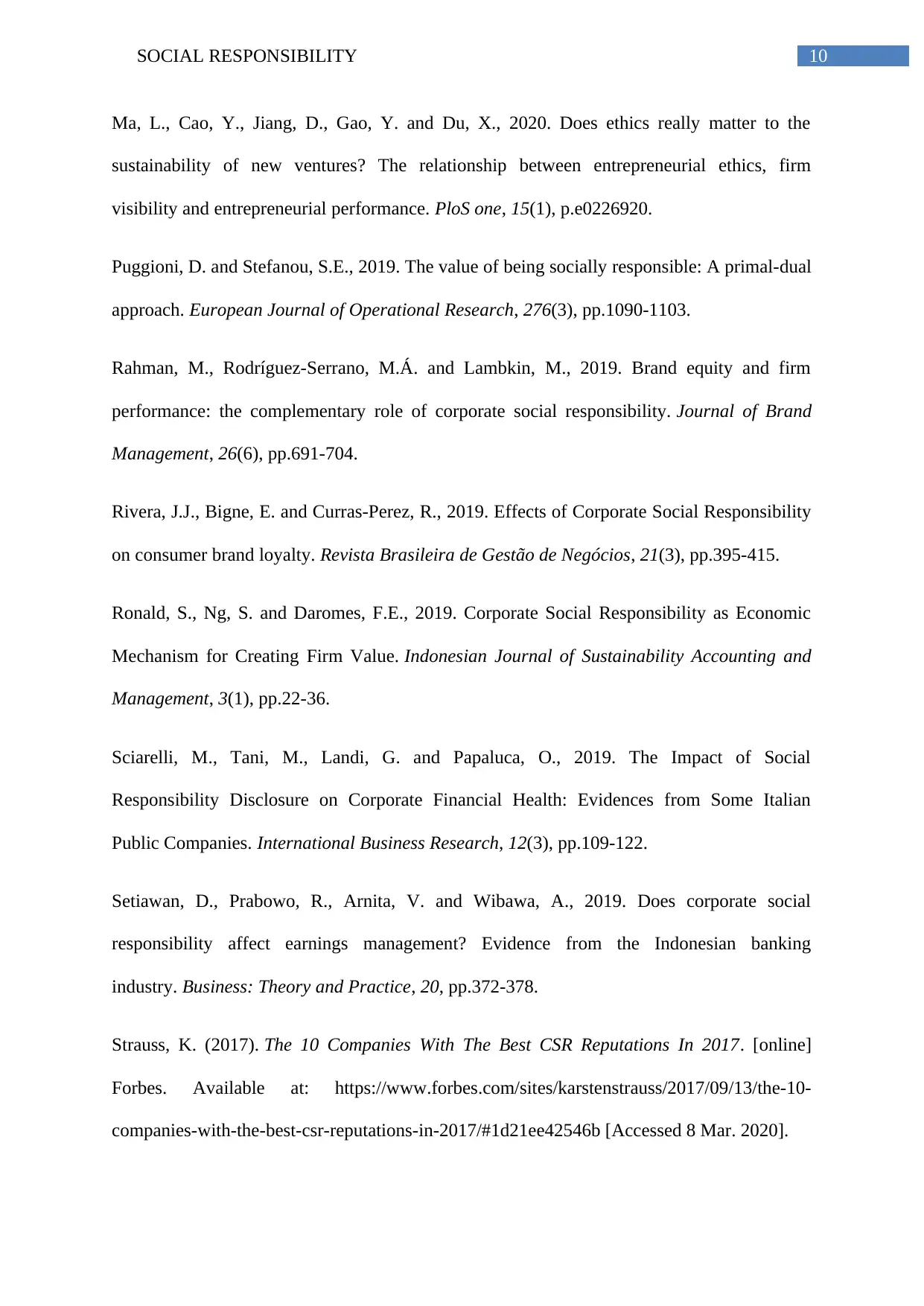
10SOCIAL RESPONSIBILITY
Ma, L., Cao, Y., Jiang, D., Gao, Y. and Du, X., 2020. Does ethics really matter to the
sustainability of new ventures? The relationship between entrepreneurial ethics, firm
visibility and entrepreneurial performance. PloS one, 15(1), p.e0226920.
Puggioni, D. and Stefanou, S.E., 2019. The value of being socially responsible: A primal-dual
approach. European Journal of Operational Research, 276(3), pp.1090-1103.
Rahman, M., Rodríguez-Serrano, M.Á. and Lambkin, M., 2019. Brand equity and firm
performance: the complementary role of corporate social responsibility. Journal of Brand
Management, 26(6), pp.691-704.
Rivera, J.J., Bigne, E. and Curras-Perez, R., 2019. Effects of Corporate Social Responsibility
on consumer brand loyalty. Revista Brasileira de Gestão de Negócios, 21(3), pp.395-415.
Ronald, S., Ng, S. and Daromes, F.E., 2019. Corporate Social Responsibility as Economic
Mechanism for Creating Firm Value. Indonesian Journal of Sustainability Accounting and
Management, 3(1), pp.22-36.
Sciarelli, M., Tani, M., Landi, G. and Papaluca, O., 2019. The Impact of Social
Responsibility Disclosure on Corporate Financial Health: Evidences from Some Italian
Public Companies. International Business Research, 12(3), pp.109-122.
Setiawan, D., Prabowo, R., Arnita, V. and Wibawa, A., 2019. Does corporate social
responsibility affect earnings management? Evidence from the Indonesian banking
industry. Business: Theory and Practice, 20, pp.372-378.
Strauss, K. (2017). The 10 Companies With The Best CSR Reputations In 2017. [online]
Forbes. Available at: https://www.forbes.com/sites/karstenstrauss/2017/09/13/the-10-
companies-with-the-best-csr-reputations-in-2017/#1d21ee42546b [Accessed 8 Mar. 2020].
Ma, L., Cao, Y., Jiang, D., Gao, Y. and Du, X., 2020. Does ethics really matter to the
sustainability of new ventures? The relationship between entrepreneurial ethics, firm
visibility and entrepreneurial performance. PloS one, 15(1), p.e0226920.
Puggioni, D. and Stefanou, S.E., 2019. The value of being socially responsible: A primal-dual
approach. European Journal of Operational Research, 276(3), pp.1090-1103.
Rahman, M., Rodríguez-Serrano, M.Á. and Lambkin, M., 2019. Brand equity and firm
performance: the complementary role of corporate social responsibility. Journal of Brand
Management, 26(6), pp.691-704.
Rivera, J.J., Bigne, E. and Curras-Perez, R., 2019. Effects of Corporate Social Responsibility
on consumer brand loyalty. Revista Brasileira de Gestão de Negócios, 21(3), pp.395-415.
Ronald, S., Ng, S. and Daromes, F.E., 2019. Corporate Social Responsibility as Economic
Mechanism for Creating Firm Value. Indonesian Journal of Sustainability Accounting and
Management, 3(1), pp.22-36.
Sciarelli, M., Tani, M., Landi, G. and Papaluca, O., 2019. The Impact of Social
Responsibility Disclosure on Corporate Financial Health: Evidences from Some Italian
Public Companies. International Business Research, 12(3), pp.109-122.
Setiawan, D., Prabowo, R., Arnita, V. and Wibawa, A., 2019. Does corporate social
responsibility affect earnings management? Evidence from the Indonesian banking
industry. Business: Theory and Practice, 20, pp.372-378.
Strauss, K. (2017). The 10 Companies With The Best CSR Reputations In 2017. [online]
Forbes. Available at: https://www.forbes.com/sites/karstenstrauss/2017/09/13/the-10-
companies-with-the-best-csr-reputations-in-2017/#1d21ee42546b [Accessed 8 Mar. 2020].
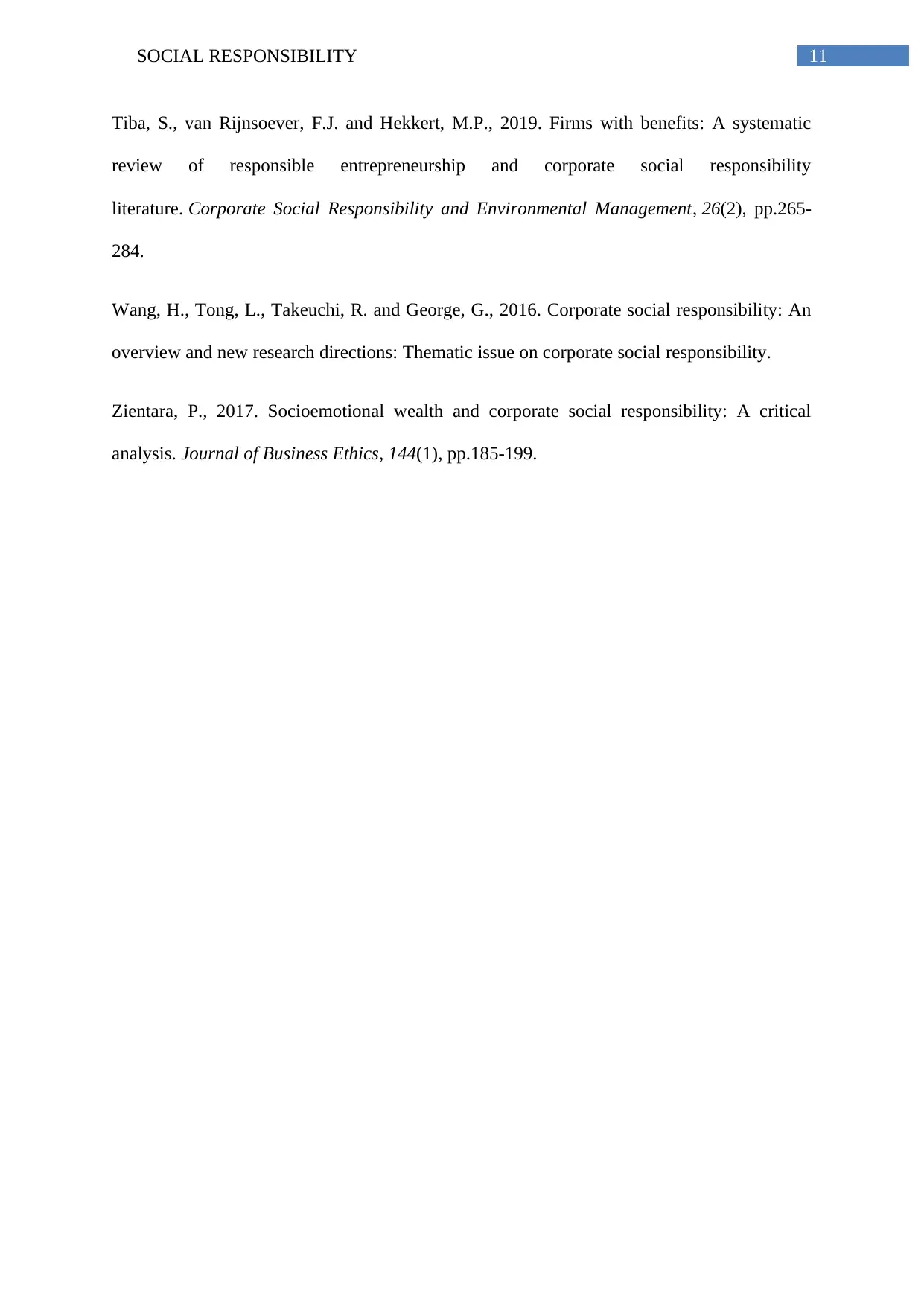
11SOCIAL RESPONSIBILITY
Tiba, S., van Rijnsoever, F.J. and Hekkert, M.P., 2019. Firms with benefits: A systematic
review of responsible entrepreneurship and corporate social responsibility
literature. Corporate Social Responsibility and Environmental Management, 26(2), pp.265-
284.
Wang, H., Tong, L., Takeuchi, R. and George, G., 2016. Corporate social responsibility: An
overview and new research directions: Thematic issue on corporate social responsibility.
Zientara, P., 2017. Socioemotional wealth and corporate social responsibility: A critical
analysis. Journal of Business Ethics, 144(1), pp.185-199.
Tiba, S., van Rijnsoever, F.J. and Hekkert, M.P., 2019. Firms with benefits: A systematic
review of responsible entrepreneurship and corporate social responsibility
literature. Corporate Social Responsibility and Environmental Management, 26(2), pp.265-
284.
Wang, H., Tong, L., Takeuchi, R. and George, G., 2016. Corporate social responsibility: An
overview and new research directions: Thematic issue on corporate social responsibility.
Zientara, P., 2017. Socioemotional wealth and corporate social responsibility: A critical
analysis. Journal of Business Ethics, 144(1), pp.185-199.
1 out of 12
Related Documents
Your All-in-One AI-Powered Toolkit for Academic Success.
+13062052269
info@desklib.com
Available 24*7 on WhatsApp / Email
![[object Object]](/_next/static/media/star-bottom.7253800d.svg)
Unlock your academic potential
© 2024 | Zucol Services PVT LTD | All rights reserved.





